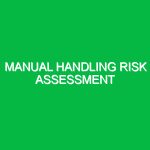Back injuries are one of the most prevalent workplace injuries across various industries, significantly impacting individuals’ lives and organizational productivity. The term “preventing back injuries” encompasses a range of strategies and practices aimed at minimizing the risk of back-related ailments, particularly in the context of Health, Safety, and Environment (HSE) protocols. Understanding back injuries and implementing effective preventive measures is not just a regulatory obligation; it is a fundamental aspect of promoting a safer working environment.
Understanding Back Injuries: The Relevance in HSE
Back injuries can manifest in various forms, including sprains, strains, herniated discs, and chronic pain conditions. According to the Bureau of Labor Statistics, back injuries account for a significant percentage of workplace injuries, leading to a high number of lost workdays. In the HSE context, preventing back injuries is crucial not only for individual well-being but also for maintaining operational efficiency and reducing healthcare costs.
Consider an individual working in construction who frequently lifts heavy materials without proper technique. Over time, this behavior may lead to a debilitating back injury, resulting in lengthy recovery periods and lost wages. Such scenarios underscore the importance of preventive measures and safety protocols in the workplace.
Identifying Hazards and Risks Associated with Back Injuries
Several hazards can contribute to back injuries. Understanding these risks is the first step toward effective prevention.
1. Manual Handling
Manual handling refers to any activity that requires the use of physical force to lift, lower, push, pull, or carry an object. Improper lifting techniques are a common cause of back injuries. For instance, lifting a heavy box from a low position without bending at the knees can place undue strain on the lower back.
2. Poor Ergonomics
Workstations that do not accommodate the natural curvature of the spine can lead to prolonged sitting or awkward postures, resulting in chronic pain and injuries. For example, an office worker sitting for hours in a poorly designed chair may develop back issues over time.
3. Slips, Trips, and Falls
Environmental hazards such as wet floors, uneven surfaces, or cluttered walkways can lead to falls, causing sudden back injuries. A slip on a wet surface can result in immediate and severe impact injuries to the back.
4. Repetitive Motions
Engaging in repetitive tasks without breaks can lead to muscle fatigue and strain. For instance, factory workers who perform the same lifting motion repeatedly may experience cumulative injuries over time.
Safety Precautions and Best Practices for Preventing Back Injuries
Implementing safety precautions is vital in mitigating the risks associated with back injuries. Below are best practices that organizations and individuals can adopt.
1. Proper Lifting Techniques
Training employees on proper lifting techniques is essential. Individuals should be taught to:
- Stand close to the load.
- Bend at the knees, not the waist.
- Keep the back straight and lift with the legs.
- Hold the load close to the body.
- Avoid twisting the torso while lifting.
For instance, during a safety training session, a supervisor might demonstrate correct lifting techniques using real-life scenarios relevant to the workforce, reinforcing the importance of these practices.
2. Ergonomic Workplace Design
Employers should invest in ergonomic assessments of workstations. This includes:
- Adjustable chairs that offer lumbar support.
- Height-adjustable desks for standing or sitting options.
- Properly positioned computer monitors to reduce neck strain.
A personal anecdote: a colleague once shared how switching to an adjustable desk improved her posture and significantly reduced her back pain. This highlights the difference ergonomic considerations can make.
3. Use of Assistive Devices
Employers should encourage the use of assistive devices such as:
- Forklifts and dollies for transporting heavy items.
- Back support belts for those in physically demanding roles.
- Grab bars and handrails in areas prone to slips and falls.
Implementing these devices can substantially reduce the physical strain on employees.
4. Regular Breaks and Stretching
Encouraging regular breaks can help prevent fatigue and strain. Simple stretching exercises during breaks can enhance flexibility and reduce tension in the back. For example, a five-minute stretch every hour can do wonders for muscle recovery.
5. Creating a Safety Culture
Organizations must foster a culture that prioritizes safety. This includes:
- Regular safety training and workshops.
- Open communication regarding safety concerns.
- Incentives for safe practices and reporting hazards.
Sharing stories of near-misses or injuries can serve as vivid reminders of the importance of adhering to safety protocols, creating an environment where everyone feels responsible for safety.
Regulations and Standards Governing Back Injury Prevention
Various regulations govern the prevention of back injuries in the workplace. The Occupational Safety and Health Administration (OSHA) provides guidelines focusing on ergonomic practices and manual handling. Key standards include:
- OSHA’s General Duty Clause, which mandates employers provide a safe workplace.
- OSHA’s Ergonomics Program, which outlines strategies for reducing ergonomic hazards.
Additionally, industry-specific regulations may apply, such as those in construction, healthcare, and manufacturing. Employers should stay abreast of these regulations to ensure compliance and promote safety.
Conclusion: The Path Forward in Preventing Back Injuries
Preventing back injuries is a multifaceted challenge that requires a proactive approach from both employers and employees. By identifying hazards, implementing safety precautions, and adhering to regulatory standards, we can create a safer work environment for everyone. The journey involves continuous education, open communication, and a commitment to safety culture. Ultimately, investing in back injury prevention not only protects the workforce but also enhances overall productivity and morale.
As we continue to navigate the evolving landscape of workplace safety, let us remember that preventing back injuries is not just about compliance; it is about caring for the well-being of every individual in the workplace. Together, we can build a healthier, safer future.


